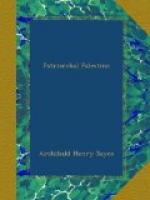Jacob and Esau met and were reconciled, and Jacob then journeyed onwards to Succoth, “the booths.” The site of this village of “booths” is unknown, but it could not have been far from the banks of the Jordan and the road to Nablus. The neighbourhood of Shechem, called in Greek times Neapolis, the Nablus of to-day, was the next resting-place of the patriarch. If we are to follow the translation of the Authorised Version, it would have been at “Shalem, a city of Shechem,” that his tents were pitched. But many eminent scholars believe that the Hebrew words should rather be rendered: “And Jacob came in peace to the city of Shechem,” the reference being to his peaceable parting from his brother. There is, however, a hamlet still called Salim, nearly three miles to the east of Nablus, and it may be therefore that it was really at a place termed Shalem that Jacob rested on his way. In this case the field bought from Hamor, “before the city of Shechem,” cannot have been where, since the days of our Lord, “Jacob’s well” has been pointed out (S. John iv. 5, 6). The well is situated considerably westward of Salim, midway, in fact, between that village and Nablus, and close to the village of ’Askar, with which the “Sychar” of S. John’s Gospel has sometimes been identified. It has been cut through the solid rock to a depth of more than a hundred feet, and the groovings made by the ropes of the waterpots in far-off centuries are still visible at its mouth. But no water can be drawn from it now. The well is choked with the rubbish of a ruined church, built above it in the early days of Christianity, and of which all that remains is a broken arch. It has been dug at a spot where the road from Shechem to the Jordan branches off from that which runs towards the north, though Shechem itself is more than a mile distant. We should notice that S. John does not say that the well was actually in “the parcel of ground that Jacob gave to his son Joseph,” only that it was “near to” the patriarch’s field.




